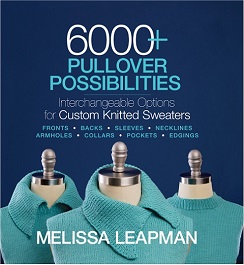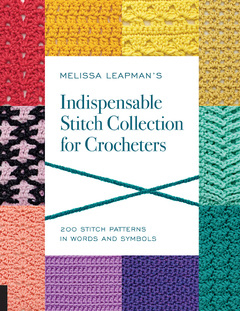
Have you been hesitant to design your own knitted sweaters? Or have you tried designing your own sweaters but given up because doing all that math holds you back — or the process is too time consuming? Would you be interested in finding an incredible shortcut through the math so you can get to the fun part of knitted sweater design? If so, I think you’ll be excited to check out Melissa Leapman’s new book called 6,000+ Pullover Possibilities.
Folks, this is the holy grail of introductory sweater design books. Armed with this book, a pair of knitting needles and the yarn of your choice, you’ll be on your way to designing — and knitting — almost any style of pullover sweater your heart could desire — in any size ranging from XS through 4XL.
What You Need to Know About This Knitting Book:
Author: Melissa Leapman
Publisher: Sixth & Spring Books
Copyright Date: 2017
ISBN 13: 978-1-936096-94-7
Book Format: Hardcover with concealed spiral binding
Number of Pages: This book has a whopping 264 pages!
Cover Price: $24.95 US dollars / $27.95 in Canada
The Focus of This Book:
This book’s purpose is helping you design your own custom hand-knitted sweaters. The book gives you a thorough, systematic exploration of just about every major silhouette option a knitter would be likeliest to want in a weft-knitted sweater — complete with instructions for how to knit each option in a variety of gauges and for a variety of sizes.
This book will guide you through the process of customizing the silhouette, sleeves, neckline, edges and other details of your knitted pullover sweaters. You’ll have the opportunity to choose the fit you want — from close fitting to oversized. You have a mind-boggling number of options, whether you want to knit a hoodie, a turtleneck, a crew neck, a sweater with a collar or some other type of style. You can add pockets, plackets, buttons or zippers — or not.
The book includes helpful reference sections covering the knitting techniques and finishing techniques you’ll need to successfully complete the sweaters you knit using these instructions.
The Best Things About This Knitting Book:
This book is a HUGE time saver! Even if you’re an experienced, talented knit designer and an expert mathematician, this book could save you many hours’ worth of calculation time on future projects.
The design work in the book is appealing.
The book is accessible and useful to knitters in a wide range of sizes.
The spiral binding is a feature that many knowledgeable knitters prefer. This type of binding is desirable because it opens easily, it stays open while you are working from it and the pages tend to stay put unless you intentionally make an effort to turn them.
The book includes clearly presented charts, schematics and photographs.
The section on edge finishes is particularly outstanding. It gives you instructions for 19 different types of sweater hems and edging treatments you can apply to your sweaters to finish them flawlessly. Some of the descriptions include helpful tips on which knitting needles to use.
In addition to the basic edges like k1p1 rib that knitters use often, there are two lace edges, two multicolor edges, four cable and twist edges and instructions for a couple of simple, appealing stockinette hems. The two colorwork patterns are both designs that enable you to carry your yarns up the sides of your work without having to weave in huge numbers of loose ends.
The reference information in the book is useful and straightforward.
The seaming information is particularly helpful. When you sew the pieces together on a sweater, the stitches can face in different directions. This can complicate the the task of sewing your seams. Melissa shares three tutorials for how to join knitted pieces with mattress stitch; once you understand these ideas, you’ll be able to seam with confidence — even if you need to stitch seams in areas where your stitches are facing in different directions. Melissa also gives you instructions for backstitch seams and whipstitch seams. Her instructions include brief explanations of why you’d want to use each type of seam.
The table of contents and index make it easy to find the information you need in the book.
Other Observations About This Book
There’s a helpful fill-in-the-blanks checklist you can use to make notes about your project. Since only one of these is included in the book, you’ll need to make copies of it if you intend to design more than one sweater using the book’s contents.
This volume has a textbookish type of feel. The presentation is straightforward and utilitarian. The book has matte pages. The design and contents of this book are classic enough that I wouldn’t be surprised to see this title still in print 20+ years from now.
In the book’s introduction, Melissa gives you clear, concise and helpful step-by-step instructions for how to design your own custom hand-knitted sweater using the book’s contents.
The library of style choices is as thorough as could be expected for a single volume on the topic of pullover sweater design. Sweater design is a vast and bottomless subject; one book couldn’t possibly cover everything there is to say about it — and so, of course, this one doesn’t. Melissa couldn’t have covered much more without expanding into a multi-volume set of books — which actually wouldn’t be a bad idea.
The things I found most obviously missing from the book:
- There are no suggestions for how to translate these silhouettes into stitch combinations other than simple stockinette. This is a topic that could easily turn one book into an ongoing series if Melissa were to write a follow-up.
- There’s little discussion about incorporating design elements such as cables or colorwork patterns into your custom-designed creations. As I mentioned above, the section on edge treatments does incorporate lovely choices for colorwork and cable-knit trims; the book also includes instructions for a lace collar. Other than that, you’re on your own if you want to include more advanced-level design elements in your pullover knit sweaters.
- There’s no mention of shaping techniques like darts that go beyond simple increases and decreases. This is another topic that could fill a separate book’s worth of follow-up content.
Depending on how you look at it, omission of these concepts could actually be viewed as beneficial in one important way: The design process as Melissa introduces it here remains simple enough to be accessible to knitters of all skill levels, including new knitters.
The more complexities you introduce into the design process, the more likely it becomes that you’ll get bogged down in details and give up in frustration before completing a design. This is particularly true if you’re a new knit designer. The beauty of Melissa’s book is that it streamlines the design process, breaking every part of the process down into manageable steps. This increases the likelihood that you’ll emerge from the process with finished sweaters you’re proud of.
Once you ‘re comfortable with the design process, there’s nothing stopping you from incorporating more complex stitch combinations, colorwork patterns, cables and other design elements into your creations. If you’d like to do this, there are a couple of additional resources I highly recommend adding to your knitting library:
- The Cable Knitter’s Guide by Denise Sampson — This book will give you cable knitting patterns plus TONS of inspiration for incorporating simple and complex cables into your sweater designs. The book also includes detailed information about where you can find video stitch tutorials that go along with each cable pattern — giving you ample support to succeed with implementing lovely cables into your unique sweater designs.
- Japanese Knitting Stitch Bible by Hitomi Shida — The jaw-dropping-INCREDIBLE lace, cable and textured knitting stitch patterns in this stitch dictionary will give you the means to design some of the most impressive knitwear pieces you could possibly imagine.
You don’t need ANY of these additional resources to succeed with your sweater design work; but if you want to add colorwork, cable patterns or lace patterns to your sweaters, all of those resources are good ones to consider buying in addition to 6,000+ Pullover Possibilities.
In this book, Melissa focuses exclusively on giving you instructions for knitting seamed pullovers. If as a rule you’d prefer to always knit your pullovers in the round, this is not the book for you.
As an introduction to sweater knit design, I’d consider this book a complete success. It isn’t a comprehensive guide that covers every last possibility, but it’s a fantastic guide to the most important basics you need to get started with sweater knit design.
I found this book to be well organized and logical in its presentation. However, a resulting tradeoff is that there’s a whole lot of wasted space in the book. It’s a hefty book that borders on being cumbersome. This isn’t a book I want to just toss in my tote and take places with me. I cringe a bit at the thought of even putting the book in a photocopy machine to make copies of the fill-in-the-blanks checklist (So I emailed the publisher’s publicist to suggest they make an online printable version available).
The fonts used in the book are tasteful, but they’re on the small side. I’m able to read the text even with vision challenges and a three-years-out-of-date eyeglasses prescription, but I would have appreciated a more substantial font. If your preference is for large-print books, you may be disappointed with this book’s format.
Conclusion
I’m delighted to recommend this book to other knitting enthusiasts, particularly aspiring knit designers who have found the design process daunting up until now. I hope you’ll add this book to your library and give designing another try.
If you’re an experienced knit designer already, this book isn’t an essential addition to your library, but I think you’ll find it to be a fantastic shortcut for mapping out your sweater designs and getting the math out of the way so you can get started knitting faster.
I think this book is accessible to new knitters, although I wouldn’t recommend a custom-knit sweater as a first knitting project. If you want to knit sweaters and you’ve been knitting long enough that you’re comfortable working at an even tension in basic stockinette stitch, I think this book is likely to be a good investment for you.
With a cover price of only $24.95 US dollars / $27.95 in Canada, this book is an outstanding value. I think the book is worth buying at its full cover price, but you probably won’t have to pay full price. The retailers I’ve linked to below often sell books at discounted prices; if you’re able to find this book on sale for less than its cover price, it’s an even better value.
Where to Buy 6,000+ Pullover Possibilities by Melissa Leapman:
More Melissa Leapman Books:
- Click here to check out my book review of Melissa Leapman’s Indispensable Stitch Collection for Crocheters at knittingcrochetcrafts.com.
- Click here to shop for Melissa Leapman’s Indispensable Stitch Collection for Crocheters at Amazon.com.
- Want to learn how to do the mosaic crochet technique, or find some stylish new hat patterns to work on? Click here to check out Learn to Crochet Mosaic Hats by Melissa Leapman.
- Click here to shop for Melissa Leapman’s Designer Crochet Accessories book at Amazon.com.
- Click here to learn more about Melissa’s book called Cables Untangled.
- Click here to find more info about Melissa’s book, Continuous Cables.
- Click here to check out Melissa’s book called Knitting the Perfect Fit.

More Knitting Books You Might Enjoy:
Knitting Tools and Supplies
This page was last updated on 8-4-2023.